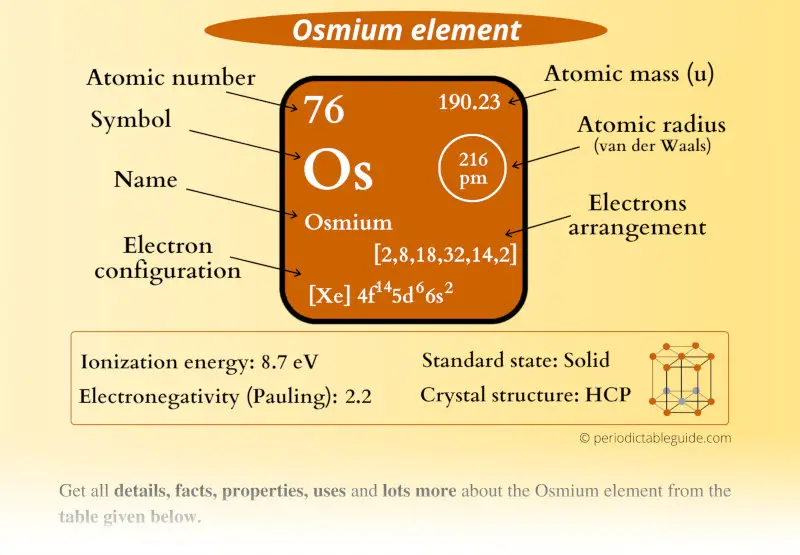
This is a SUPER easy guide on Osmium element.
In fact, the table mentioned below is the perfect information box (Which gives you every single detail about the Osmium element in Periodic table.)
So if you want to know anything about Osmium element, then this guide is for you.
Let’s finish this very quickly.
Osmium Element (Os) Information
| Appearance | 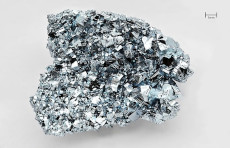 Silvery-blue luster |
| State (at STP) | Solid |
| Position in Periodic table |  Group: 8, Period: 6, Block: d |
| Category | 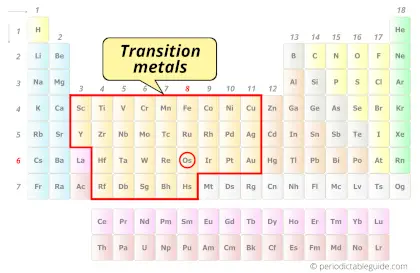 Transition metals |
| Atomic number or Protons | 76 |
| Neutrons | 114 |
| Electrons | 76 |
| Symbol | Os |
| Atomic mass | 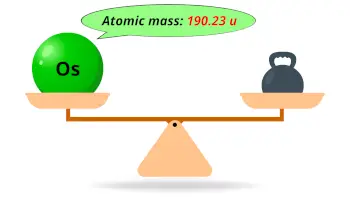 190.23 u |
| Electrons arrangement or Bohr model | 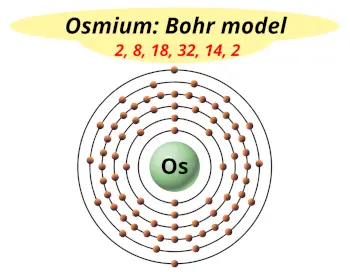 2, 8, 18, 32, 14, 2 |
| Electronic configuration | [Xe] 4f14 5d6 6s2 |
| Atomic radius | 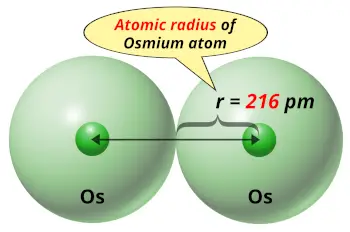 216 picometers (van der Waals radius) |
| 1st Ionization energy | 8.7 eV |
| Electronegativity | 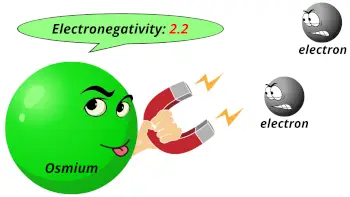 2.2 (Pauling scale) |
| Crystal structure | 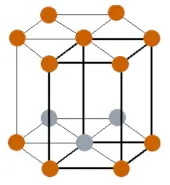 HCP (Hexagonal close packed) |
| Melting point | 3306 K or 3033 °C or 5491 °F |
| Boiling point | 5285 K or 5012 °C or 9054 °F |
| Density | 22.6 g/cm3 |
| Main isotope | 192Os |
| Who discovered Osmium and when? | Smithson Tennant (in 1803) |
| CAS number | 7440-04-2 |
Osmium in Periodic table
Osmium element is in group 8 and period 6 of the Periodic table. Osmium is the d-block element and it belongs to transition metals group.
| H | He | ||||||||||||||||
| Li | Be | B | C | N | O | F | Ne | ||||||||||
| Na | Mg | Al | Si | P | S | Cl | Ar | ||||||||||
| K | Ca | Sc | Ti | V | Cr | Mn | Fe | Co | Ni | Cu | Zn | Ga | Ge | As | Se | Br | Kr |
| Rb | Sr | Y | Zr | Nb | Mo | Tc | Ru | Rh | Pd | Ag | Cd | In | Sn | Sb | Te | I | Xe |
| Cs | Ba | La* | Hf | Ta | W | Re | Os | Ir | Pt | Au | Hg | Tl | Pb | Bi | Po | At | Rn |
| Fr | Ra | Ac** | Rf | Db | Sg | Bh | Hs | Mt | Ds | Rg | Cn | Nh | Fl | Mc | Lv | Ts | Og |
| *Ce | Pr | Nd | Pm | Sm | Eu | Gd | Tb | Dy | Ho | Er | Tm | Yb | Lu | ||||
| **Th | Pa | U | Np | Pu | Am | Cm | Bk | Cf | Es | Fm | Md | No | Lr |
←Move to: Rhenium (Re) element – Periodic Table
→Move to: Iridium (Ir) element – Periodic Table
Why is Osmium in Period 6?
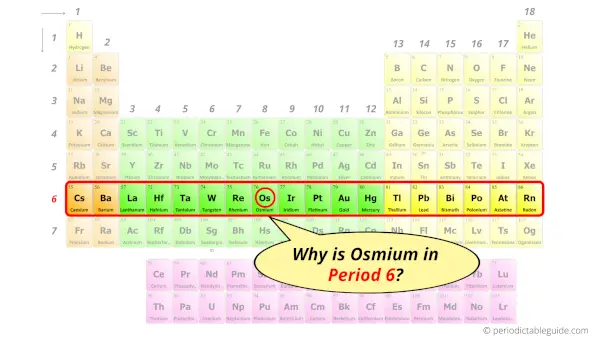
Let me ask you a question.
How many shells does osmium atom have?
It’s 6. Right?
You have already seen the bohr model of osmium atom in the above table.
From the Bohr model, it can be found that the number of orbits or shells in osmium is 6. Hence, as osmium has 6 orbits, it lies in period 6 of the Periodic table.
Why is Osmium in d-block?
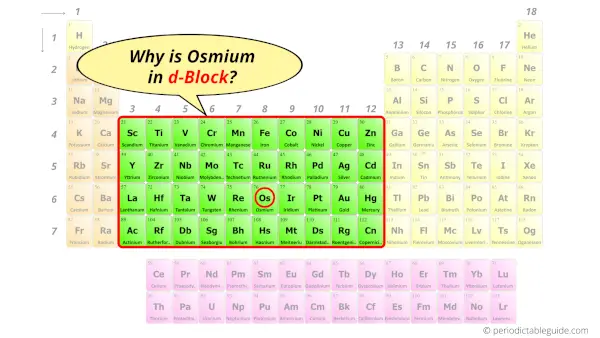
Before knowing this reason, first of all I want to ask you a simple question.
How can you determine the blocks-wise position of elements?
The simple answer: The elements will lie in the s, p, d or f block will completely depend upon the subshell in which the last electron will enter.
For example; the electron configuration of osmium is [Xe] 4f14 5d6 6s2.
So the last electron of osmium enters the d-subshell or d-orbital.
Hence, osmium is the d-block element.
Is Osmium a Transition Metal? Why?
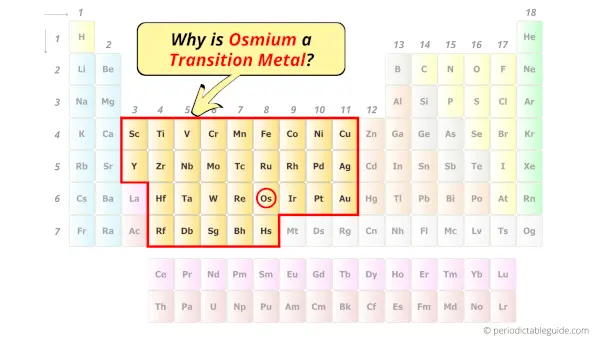
Yes, Osmium is a transition metal because it has incompletely filled d-orbital in its ground state.
Let me explain the exact meaning of this.
According to the definition of transition metals;
The element should compulsorily have incomplete d-orbitals, either in their ground state (M) or most common oxidation states (M1+, M2+, etc) then only they are called transition metals.
Now, the ground state of Osmium means its normal state in which it has neither gained nor lost any electron/s.
So the ground state of Osmium is Os.
And the ground state electronic configuration of Osmium is [Xe] 4f14 5d6 6s2.
In this state, if we see the electron configuration of Osmium, then it possesses incomplete d-orbitals.

Because, there are only six electrons in the d-orbitals (here 5d orbitals).
In order to have the complete d-orbitals, there must be 10 electrons in it.
But in the ground state electronic configuration of osmium, you can see that it has only 6 electrons in d-orbitals.
Thus, Osmium has incomplete d-orbitals.
And hence, as Osmium has incomplete d-orbitals, it is considered as a transition metal.
5 Interesting facts about Osmium
Interesting facts about osmium element are mentioned below.
- The name osmium was derived from the Greek word “osme”, which means smell or odor.
- Osmium was discovered by Smithson Tennant in 1803 (in London).
- Osmium is the most dense element present on the periodic table of elements. It has a density of 22.6 g/cm3.
- The osmium element is present in rare quantities in the earth’s crust and its concentration in earth’s crust is only 1.5 parts per billion by weight.
- Osmium is mostly found in the platinum ores and it is also obtained as a byproduct of nickel refining.
Properties of Osmium
The physical and chemical properties of osmium element are mentioned below.
Physical properties of Osmium
Physical properties of osmium are mentioned below.
- Osmium is a solid dense metal having silvery-blue lustre.
- The atomic mass of osmium is 190.23 u and its density is 22.6 g/cm3.
- The melting point of osmium is 3033 °C and its boiling point is 5012 °C.
- The osmium element has a HCP (Hexagonal close packed) crystal structure.
- There are many isotopes of osmium, but out of those isotopes, the most abundant isotope is 192Os (which has an abundance of approximately 40.7%).
Chemical properties of Osmium
Chemical properties of osmium are mentioned below.
- The solid osmium does not show any reaction with air at room temperature, but its powdered form is reactive and it forms osmium tetroxide (OsO4).
- Osmium tetroxide OsO4 (which is a compound of osmium) is highly toxic and has an unpleasant smell.
- The electron configuration of osmium is [Xe] 4f14 5d6 6s2, which has incomplete d-orbitals. This indicates that the osmium element is a transition element.
- The osmium element has multiple oxidation states ranging from -2 to +8.
Uses of Osmium
Uses of osmium are mentioned below.
- As osmium has a highest density, it is used as an alloying element with other metals to make them hard.
- Alloys of osmium are also used for electrical contacts as well as in making fountain pen tips.
- The alloy containing 10% osmium and 90% platinum is used in making pacemakers as it is highly resistive to corrosion.
Explore our New Interactive Periodic Table (with Rotating Bohr Models and More)

Details about this Periodic table:
- Access detailed info on all elements: atomic mass, electron configurations, charges, and more.
- View rotating Bohr models for all 118 elements.
- Get a free HD image of the Periodic Table.
Note: For future use, bookmark this Periodic table or visit “PeriodicTableGuide.com”
External resources:
- Osmium – Wikipedia. (2018, May 10). Osmium – Wikipedia. https://en.wikipedia.org/wiki/Osmium
- Osmium – Element information, properties and uses | Periodic Table. (n.d.). Osmium – Element Information, Properties and Uses | Periodic Table. https://www.rsc.org/periodic-table/element/76/osmium
- P. (n.d.). Osmium | Os (Element) – PubChem. Osmium | Os (Element) – PubChem. https://pubchem.ncbi.nlm.nih.gov/element/Osmium
- It’s Elemental – The Element Osmium. (n.d.). It’s Elemental – the Element Osmium. https://education.jlab.org/itselemental/ele076.html
- C&EN: IT’S ELEMENTAL: THE PERIODIC TABLE – OSMIUM. (n.d.). C&EN: IT’S ELEMENTAL: THE PERIODIC TABLE – OSMIUM. http://pubsapp.acs.org/cen/80th/osmium.html?
